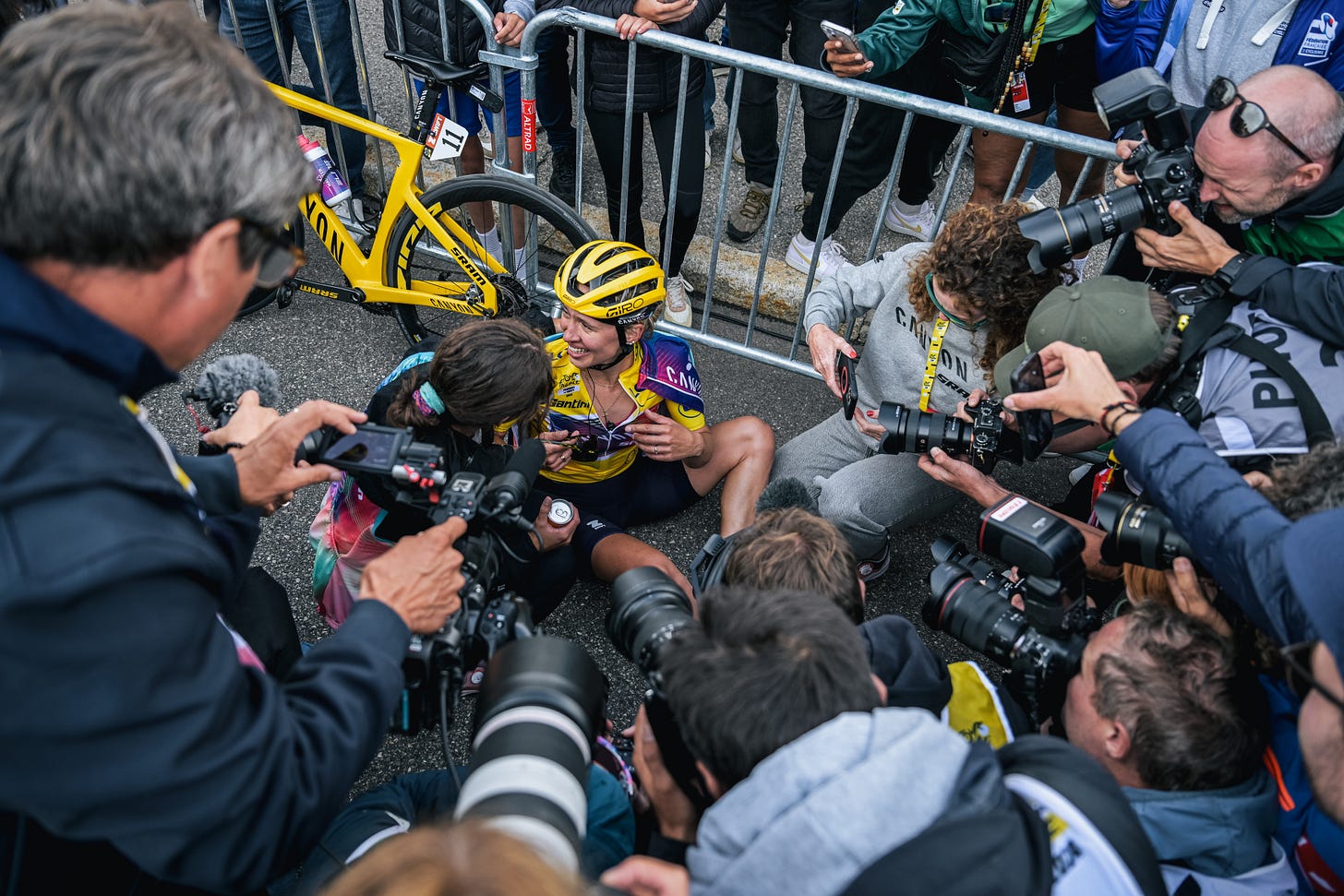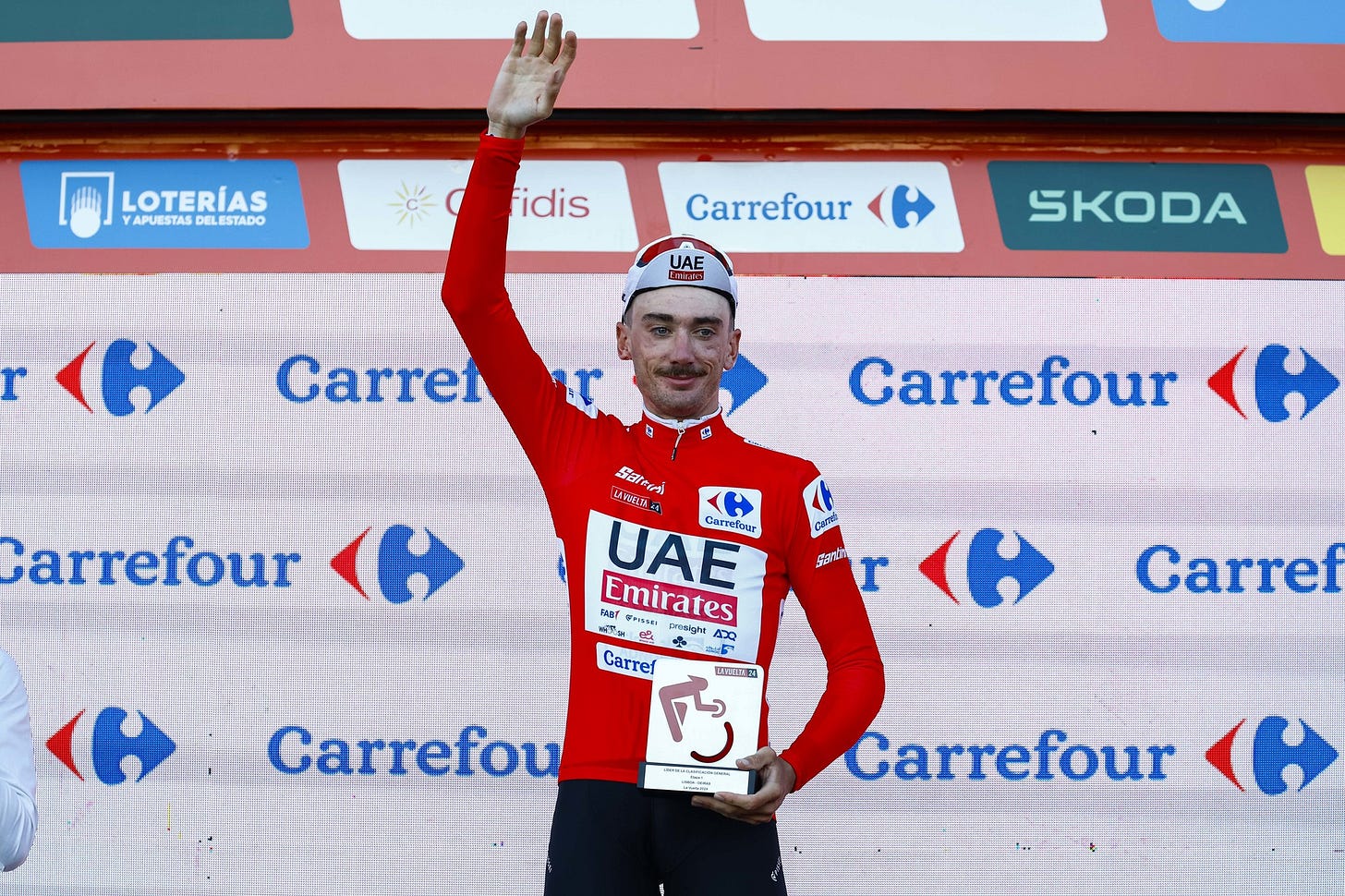I could not imagine a more perfect illustration of the forces that determine cycling races. Why, especially on a climb like Alpe d’Huez, where few riders can follow the hardest pace and drafting isn’t as much of a factor as on flat ground, is the Tour de France not just a power test? Who can put out the most watts per kilo over X number of minutes?
Every rider in the race is connected by an invisible string, and on Sunday, Demi Vollering was under just the right amount of tension from every direction. It took a unique set of circumstances to make the Tour de France Femmes the closest grand tour ever: The top three riders separated by just 10 seconds, and all three with a realistic shot at winning on GC within the final kilometer. And arguably, this was the only way anyone other than Vollering could’ve won without a total breakdown from the race favorite.
The result was one of the most thrilling race days in the history of the sport.
Kasia Niewiadoma inherited the yellow jersey and more than a minute’s cushion after Vollering’s crash on Stage 5. The two finished together on Stages 6 and 7, though Vollering took four bonus seconds for finishing third in the latter stage. So they went into the final day, a double climb of the outside-category peaks of Col du Glandon and Alpe d’Huez, in the following order: Niewiadoma first, then six riders you don’t need to worry about, then Pauliena Rooijakkers, a 31-year-old Dutch climber from Fenix-Deceuninck who had a few high GC finishes on her palmares, but only two actual professional wins.
Rooijakkers sat seventh on GC, a minute and 13 seconds behind Niewiadoma. Two seconds behind her was Vollering.
The expectation was that Vollering would peg it on the Glandon, open up a gap, and then put several minutes into the rest of her competitors. Mostly because that’s what she did to the field, including Niewiadoma, in the queen stage of last year’s Tour de France Femmes on the Col du Tourmalet.
And that’s precisely what Vollering did. She came over the Glandon having dropped Niewiadoma and every other rider in the top 10, except Rooijakkers, and came into the valley between the final two climbs already holding the kind of lead over Niewiadoma that ought to have allowed her to take back the yellow jersey.
In mathematical terms, in order to win the Tour, Vollering had to gain 75 seconds on Niewiadoma through a combination of a real-world time gap and bonus seconds: 10 for a stage win, six for second place, four for third. Under normal circumstances, taking Rooijakkers with her would’ve been an advantage for Vollering. If she felt at all threatened, she could’ve made a deal to split the pacing workload equitably, and if she had put enough time into Niewiadoma to win the GC, she could’ve let Rooijakkers take the stage win.
Except Rooijakkers was two seconds up on Vollering in the GC battle. So there was no scenario in which Vollering could finish behind Rooijakkers on the stage but win the Tour.
So Vollering couldn’t just lay it all on the line and ride a time trial to the finish. That would’ve almost certainly put Niewiadoma out of the race, but it also would’ve given Rooijakkers a free ride to win the stage and the maillot jaune. She also couldn’t play a game of chicken with Rooijakkers, as she did with Annemiek van Vleuten on the Tourmalet last year, because that would allow Niewiadoma to catch back up.
Vollering, who was by this point all alone, had to play both ends against the middle. If she went too slow, she’d lose to Niewiadoma. If she went too fast, she’d lose to Rooijakkers.
Niewiadoma teetered on the edge of her cushion as she ascended Alpe d’Huez, also out of teammates, and doing most of the work in a group that included between two and five other riders. But none of them were a threat. Évita Muzic of FDJ, Gaia Realini and Lucinda Brand of Lidl-Trek, and Niamh Fisher-Black of SD Worx were all at least a minute and 25 seconds behind Niewiadoma, and everyone between second and sixth in the overnight standings had been dropped long ago.
As Vollering lived John Nash’s worst nightmare up the road, Niewiadoma kept on chugging. (Occasionally cheered on by her husband, retired American cycling prodigy Taylor Phinney. Phinney, a 6-foot-6 time trial specialist, had probably never gone uphill as quickly in his life as when he ran alongside Niewiadoma’s bike in the final kilometers of the stage.)1
The gap between the leaders and the yellow jersey group, which I expected to blow up sooner or later, stayed around a minute all the way up Alpe d’Huez, and then it started to come down.
Vollering played the one card she had left in her hand: She tried to drop Rooijakkers outright. But she couldn’t. Nor could Rooijakkers do the reverse. Vollering closed down her final attack within five seconds, and when she demanded Rooijakkers take a turn, the underdog could do nothing but shake her head.
A very small, very nitpicky part of me wonders if Vollering shouldn’t have given Rooijakkers a little bit more rope, let her tire herself out, then closed the gap and come over the top.2 It probably wouldn’t have mattered.
In the end, Niewiadoma pulled the gap back to well within her margin for error. Vollering dropped her companion for good only in the final few hundred meters, and when Niewiadoma came over the line there was only moderate confusion over the final timing. Music had, surprisingly, beaten Niewiadoma in the sprint for third, giving Vollering a full 10-second bonus advantage. But once the official timing came out, Vollering had gained only 61 of the 65 seconds she’d needed to defend her title.
Vollering beat Rooijakkers. She could’ve beaten Niewiadoma. But she couldn’t do both at the same time.
If you’d taken away each rider’s history, given them random names and uniforms, this still would’ve been an all-time great stage. So delicate was the balance of power throughout the day. But when Niewiadoma collapsed in tears of joy—which, to be fair, every Tour de France winner does, unless they’re made of stone—it was clear that almost everyone watching had been hoping for that conclusion.
Let me be one of the multitudes of cycling writers to dig out what I wrote after Niewiadoma won La Flèche Wallonne in April.
That victory ended a drought of nearly five years for a rider who had finished second or third or fifth at basically every intervening race. A rider who’d won worldwide acclaim for serving as a counterbalance to a series of implacable GC terminators from the Netherlands and/or SD Worx. When she finally got a significant win after half a decade of charismatic and aggressive but doomed voyages to second place, she was the toast of the sport.
The greater the suffering, the greater the catharsis, and we all felt like we’d lived that with her.
And while La Flèche Wallonne is a huge deal, it is infinitesimally small potatoes next to the Tour de France, especially a Tour de France that was decided on Alpe d’Huez. To see this serial runner-up finally get the breaks and get over the top…I mean, this is why people watch sports.
Especially because of how SD Worx handed her the victory.
With less than 10 kilometers left after the crash on Stage 5, I don’t think that dropping Lorena Wiebes to pace would’ve gotten Vollering back to the leaders. Actually, that’s not strong enough—there’s no way she would’ve gotten back to the leaders on the road. She probably wouldn’t have made up enough time to retain the overall race lead either.
But four seconds? Yeah. I don’t know much, but I know this: whether through malice or hubris or confusion or incompetence, the failure of SD Worx to go back and pace for its leader cost Vollering this race. So on one hand, catharsis. On the other, hubris. And all the other Greek drama jargon you learned in high school English and forgot a week after the AP test. If you’d scripted it this way, people would’ve called you a hack.
You know how awesome the ending to the Tour de France Femmes was? Brandon McNulty, one of my favorite riders, won the third-fastest grand tour time trial in the past 20 years to take the lead of the Vuelta a España. And it’s going below the fold.








